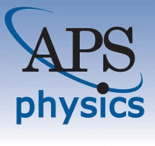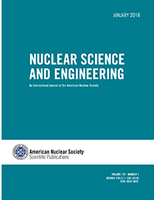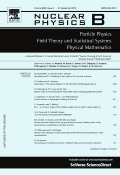
PHYSICAL REVIEW C
Scope & Guideline
Leading the Charge in Nuclear and High-Energy Physics
Introduction
Aims and Scopes
- Nuclear Structure and Dynamics:
Research in this area includes the study of nuclear shapes, energy levels, and collective excitations, often involving advanced theoretical frameworks such as the shell model, mean-field theory, and density functional theory. - Nuclear Reactions and Fusion:
This encompasses investigations into various nuclear reactions, including fusion, fission, and neutron capture processes, with analyses often employing experimental techniques to measure reaction cross-sections and decay properties. - Astrophysical Applications:
Many studies relate to the role of nuclear processes in astrophysical phenomena, such as nucleosynthesis in stars, neutron star physics, and the production of elements in supernovae. - Machine Learning and Computational Methods:
The journal has increasingly featured papers that apply machine learning techniques to nuclear physics problems, enhancing predictive models for nuclear masses and decay processes. - Quantum Mechanics and Many-Body Physics:
Research often explores quantum mechanical aspects of nuclear systems, including many-body interactions, quantum entanglement, and the implications for nuclear stability and decay. - Chiral Effective Field Theory:
Chiral effective field theory is frequently used to understand nucleon-nucleon interactions and their implications for nuclear structure and reactions, providing a robust framework for low-energy nuclear physics.
Trending and Emerging
- Neutron Star Physics:
There is a growing emphasis on the properties of neutron stars, particularly concerning their equations of state, interactions under extreme conditions, and implications for astrophysical observations. - Quantum Computing Applications:
The integration of quantum computing techniques in nuclear physics research is becoming more prevalent, facilitating complex calculations and simulations that were previously intractable. - Multinucleon Transfer Reactions:
Studies focusing on multinucleon transfer processes in nuclear reactions are gaining traction, providing insights into the formation of neutron-rich isotopes and their properties. - Nuclear Machine Learning:
The application of machine learning techniques to predict nuclear properties and analyze experimental data is rapidly emerging, indicating a trend towards data-driven approaches in nuclear research. - Collective and Correlated States:
Research on collective excitations and correlations among nucleons, particularly in exotic and neutron-rich nuclei, is increasingly prominent, highlighting the complex interplay of nuclear forces. - Chiral Effective Field Theory Applications:
The application of chiral effective field theory to understand nuclear forces and reactions is trending, as it provides a robust framework for low-energy nuclear interactions.
Declining or Waning
- Traditional Shell Model Approaches:
Although still relevant, traditional shell model studies appear to be less frequently published in favor of more complex, multi-particle interaction models and computational approaches that provide deeper insights into nuclear behavior. - Static Nuclear Models:
Research focusing on static models of nuclear structure, which do not incorporate dynamic interactions or external influences, has seen a decrease as the community shifts towards more dynamic and interactive models. - Basic Nuclear Reaction Studies:
While foundational studies remain important, there is a noticeable decline in the publication of basic nuclear reaction studies without novel theoretical or computational contributions, as the field moves towards more complex and nuanced investigations. - Isospin Symmetry Studies:
The specific focus on isospin symmetry in nuclear interactions has waned, with researchers increasingly looking at broader interactions that include symmetry breaking and other phenomena. - Fission Studies in Isolation:
Research solely focusing on fission processes without integrating them into broader frameworks, such as multi-channel approaches or statistical models, appears to be declining.
Similar Journals

ACTA PHYSICA POLONICA B
Advancing Physics through Rigorous InquiryACTA PHYSICA POLONICA B is a distinguished journal published by Jagiellonian University Press, based in Poland. This peer-reviewed publication focuses on advancing the field of Physics and Astronomy with a mission to disseminate high-quality research that spans various subfields and interdisciplinary connections. Since its inception in 1980, the journal has steadily become a reliable source of scientific discourse, continuing its commitment through 2024. With a Q3 rank in the Physics and Astronomy category, it stands as an important resource for both established and budding researchers, contributing to a deeper understanding of complex physical phenomena. The journal is indexed by Scopus, ensuring a broad reach within the academic community, although it is not classified as an open-access resource. By promoting rigorous scientific inquiry and fostering connections within the global academic landscape, ACTA PHYSICA POLONICA B plays a vital role in shaping the future of physics research.

Annual Review of Nuclear and Particle Science
Connecting Theories and Discoveries in Particle PhysicsAnnual Review of Nuclear and Particle Science is a prestigious journal published by Annual Reviews, focused on the fields of nuclear and high-energy physics. With an impressive impact factor that reflects its authority and influence—ranked Q1 in its category and holding a commendable Scopus rank of #2 out of 87, placing it in the 98th percentile—the journal serves as an essential resource for researchers, professionals, and advanced students alike. Covering pivotal developments and comprehensive reviews in nuclear and particle physics since its inception in 1978, this journal offers unparalleled insights into cutting-edge research and theoretical advancements. While it is not open access, the value of its scholarly content is evidenced by its rigorous peer-review process and its role in shaping contemporary discourse within the scientific community. With contributions from leading experts and a commitment to disseminating foundational and emerging theories, the Annual Review of Nuclear and Particle Science is indispensable for those seeking a deep understanding of the complexities in these dynamic fields.

NUCLEAR SCIENCE AND ENGINEERING
Driving Progress in Nuclear TechnologyNUCLEAR SCIENCE AND ENGINEERING, published by Taylor & Francis Inc, is a leading journal in the field of nuclear energy and engineering, providing a vital platform for disseminating cutting-edge research and advancements from both academia and industry. With an ISSN of 0029-5639 and an E-ISSN of 1943-748X, the journal boasts a notable impact factor and is categorized in the Q2 quartile for 2023, reflecting its influence and quality in the field. Covering a comprehensive scope from the inception of nuclear technology in 1969 to contemporary advancements forecasted for 2024, it ranks #38 out of 77 in the Scopus Energy – Nuclear Energy and Engineering category, placing it in the 51st percentile. Although the journal is not open access, it remains essential for researchers, professionals, and students seeking to stay abreast of the latest developments and innovations in nuclear science. Located in the heart of Philadelphia, NUCLEAR SCIENCE AND ENGINEERING contributes significantly to the advancement of nuclear engineering knowledge and practice, making it a crucial resource for anyone involved in this dynamic field.

EUROPEAN PHYSICAL JOURNAL A
Elevating the Standards of Nuclear Physics ScholarshipEUROPEAN PHYSICAL JOURNAL A (EPJ A), published by Springer, is a premier journal in the field of Nuclear and High Energy Physics, dedicated to fostering innovative research and scholarly communication within the scientific community. With an impressive impact factor that reflects its significant contribution to the discipline, EPJ A ranks in the Q1 category and boasts a Scopus rank of 24 out of 87, placing it in the 72nd percentile of its field for 2023. This journal, with its ISSN 1434-6001 and E-ISSN 1434-601X, embraces a commitment to open access, ensuring that cutting-edge research is accessible to a global audience. With coverage from 1998 to 2024, EPJ A continues to be a vital resource for researchers, professionals, and students alike, promoting collaboration, knowledge sharing, and advancements in the vast landscape of nuclear physics and high-energy interactions. Located in Germany with a representative address in New York City, this journal serves as a bridge for international scientific discourse.

Journal of Condensed Matter Nuclear Science
Bridging Disciplines for a Sustainable Nuclear Future.The Journal of Condensed Matter Nuclear Science, published by the International Society for Condensed Matter Nuclear Science in the United Kingdom, serves as a pivotal platform for researchers exploring the intersections of condensed matter physics and nuclear science. With an ISSN of 2227-3123, this journal has been actively contributing to the academic discourse from its inception in 2016 through its latest volume in 2022. Although classified in Q4 quartiles across various categories, including Atomic and Molecular Physics, Condensed Matter Physics, and Nuclear Energy and Engineering, the journal provides a unique lens on innovative approaches and perspectives that could significantly impact future research directions. This open-access journal appeals to an audience keen on investigating the theoretical and experimental aspects of condensed matter nuclear science, fostering a collaborative environment for scientists, engineers, and students alike. By advancing discussions in this niche field, it aims to attract attention and inspire groundbreaking discoveries that underpin the evolving landscape of nuclear energy and applications.

Nuclear Physics and Atomic Energy
Fostering collaboration in nuclear research.Nuclear Physics and Atomic Energy is a reputable open-access journal that focuses on the fields of nuclear physics and high-energy physics, providing a forum for researchers, professionals, and students to share their findings and advancements. Published by the Institute of Nuclear Research, National Academy of Sciences of Ukraine, this journal has been committed to disseminating knowledge since its inception in 2006, ensuring that scientific advancements remain accessible to a global audience. With an ISSN of 1818-331X and an E-ISSN of 2074-0565, the journal features a diverse array of articles that span the continued exploration and application of nuclear phenomena. Although currently categorized in the Q4 quartile for Nuclear and High Energy Physics in 2023, the journal is steadily working towards increasing its impact and engagement within the academic community. With a Scopus rank of #74 out of 87 in its category, it serves as a valuable resource for advancing crucial research in a vital scientific area. Researchers are encouraged to contribute their innovative studies to foster collaboration and knowledge sharing in this dynamic field.

PHYSICS OF ATOMIC NUCLEI
Connecting Researchers to the Heart of Nuclear SciencePHYSICS OF ATOMIC NUCLEI is a distinguished journal dedicated to advancing the understanding of nuclear and particle physics, published by PLEIADES PUBLISHING INC. With its ISSN 1063-7788 and E-ISSN 1562-692X, this journal serves as a vital resource for researchers, professionals, and students in the fields of atomic and molecular physics, as well as high-energy physics. The journal has been actively contributing to the scientific community since its inception in 1996 and continues to publish valuable findings through 2024. Despite its current standing in the Q4 category for both Atomic and Molecular Physics, and Nuclear and High Energy Physics, there is an abundance of potential for growth and impact in these disciplines, as evidenced by its placement in the Scopus rankings. While the journal does not currently offer open access, it remains committed to disseminating quality research that informs and engages the scientific community. Explore PHYSICS OF ATOMIC NUCLEI to stay at the forefront of nuclear physics research and contribute to the dialogue in this critical area of study.

ATOMIC DATA AND NUCLEAR DATA TABLES
Advancing knowledge in atomic and nuclear physics.ATOMIC DATA AND NUCLEAR DATA TABLES, published by Academic Press Inc Elsevier Science, is a leading journal in the fields of atomic and molecular physics, as well as nuclear and high energy physics. With an ISSN of 0092-640X and an E-ISSN of 1090-2090, this esteemed journal has been providing comprehensive data tables and significant research insights since its establishment in 1969. Spanning until 2024, it continues to serve as an invaluable resource for researchers and professionals aiming to deepen their understanding of atomic interactions and nuclear processes. Holding a commendable Q2 ranking in both relevant categories, it is recognized for its impact, reflected in Scopus rankings, where it ranks 25th out of 87 in Nuclear and High Energy Physics, and 87th out of 224 in Atomic and Molecular Physics. While it does not offer open access, the journal remains a crucial repository for high-quality data essential for scientific endeavors and advancements in these complex fields.

NUCLEAR PHYSICS B
Connecting Scholars in the World of Nuclear PhysicsNUCLEAR PHYSICS B, published by Elsevier, stands at the forefront of research in the dynamic field of Nuclear and High Energy Physics. Established in 1967, this prestigious journal has developed a reputation for excellence, now positioned in the Q1 category according to its 2023 quartile rankings. With an impressive Scopus rank of #21 out of 87 in its category and a commendable 76th percentile, it serves as a vital resource for scholars investigating the underlying principles of nuclear interactions and particle physics. The journal transitioned to an Open Access model in 2014, ensuring that groundbreaking research is accessible to a global audience. Its commitment to quality and innovation makes NUCLEAR PHYSICS B an essential platform for researchers, professionals, and students aiming to stay at the cutting edge of discoveries in this expansive field, contributing to the scientific discourse for nearly six decades.

Radiation Detection Technology and Methods
Exploring Cutting-Edge Techniques in Radiation DetectionRadiation Detection Technology and Methods is a prominent academic journal published by Springer Singapore Pte Ltd, dedicated to advancing the field of nuclear and high-energy physics, as well as nuclear energy and engineering. Established in 2017, this journal provides a platform for the dissemination of pioneering research and innovative methodologies in radiation detection technology. As of 2023, it holds a commendable Q2 ranking in both the categories of Nuclear and High Energy Physics and Nuclear Energy and Engineering, underscoring its significance in fostering scholarly discourse within these vital fields. With ISSN 2509-9930 and E-ISSN 2509-9949, the journal aims to cater to a diverse audience of researchers, professionals, and students, emphasizing open access to knowledge. The journal's contributions are particularly crucial for those engaged in the development of safer and more efficient radiation detection techniques, ultimately bridging the gap between theory and practical applications in energy security and health physics. For researchers seeking a dedicated outlet for their work, Radiation Detection Technology and Methods represents an invaluable resource and an opportunity to influence the future of radiation science.